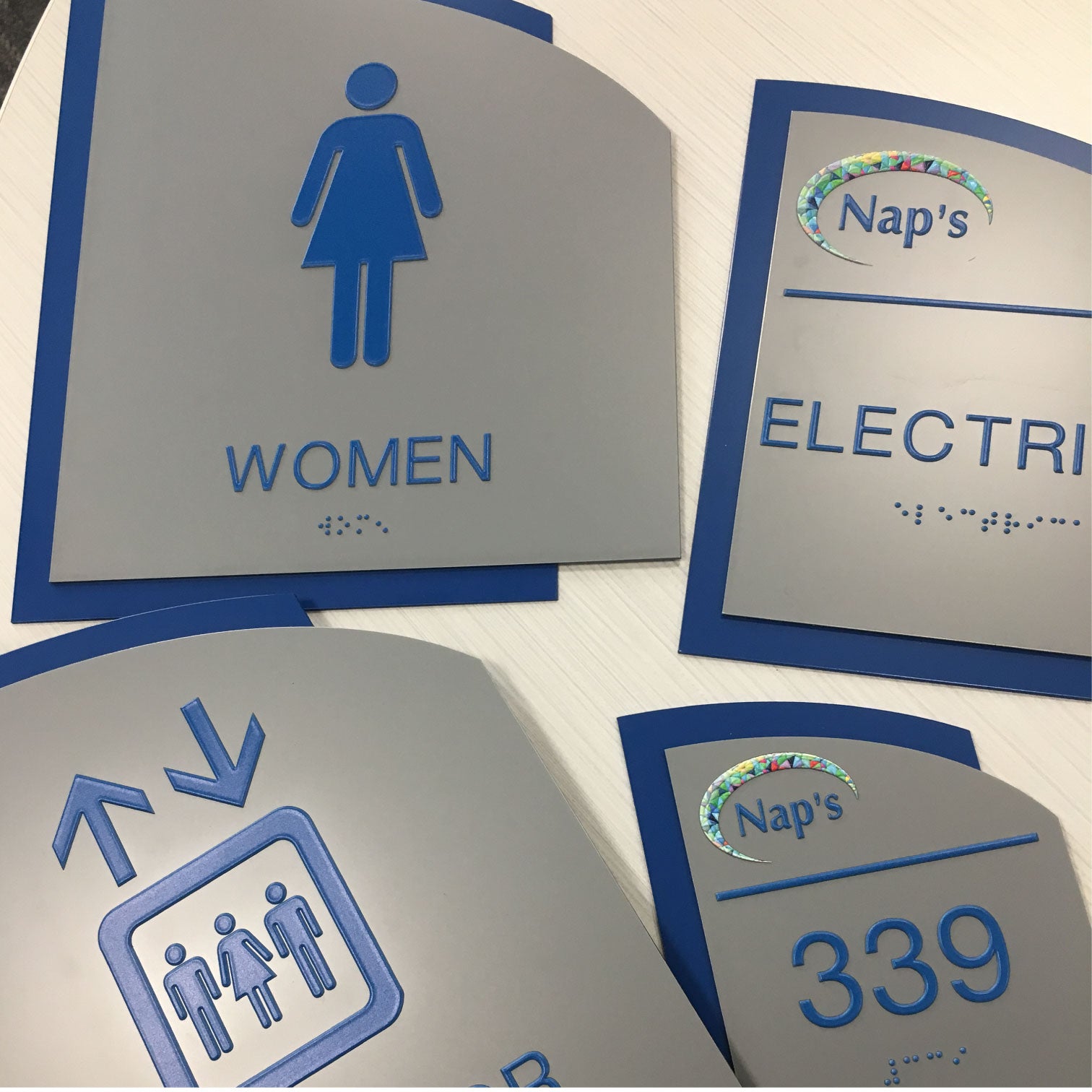How ADA Signs Enhance Availability for Everyone
How ADA Signs Enhance Availability for Everyone
Blog Article
Exploring the Key Attributes of ADA Indicators for Enhanced Accessibility
In the world of availability, ADA signs serve as quiet yet powerful allies, ensuring that areas are accessible and inclusive for individuals with specials needs. By integrating Braille and tactile aspects, these signs break obstacles for the aesthetically impaired, while high-contrast color plans and legible font styles provide to varied visual demands.
Significance of ADA Conformity
Ensuring compliance with the Americans with Disabilities Act (ADA) is critical for promoting inclusivity and equivalent accessibility in public spaces and workplaces. The ADA, enacted in 1990, mandates that all public facilities, companies, and transport solutions accommodate people with disabilities, ensuring they take pleasure in the very same rights and chances as others. Conformity with ADA standards not only fulfills legal responsibilities however additionally enhances an organization's track record by demonstrating its commitment to diversity and inclusivity.
One of the crucial aspects of ADA compliance is the implementation of obtainable signs. ADA indications are created to make sure that individuals with impairments can easily navigate with rooms and structures.
Additionally, sticking to ADA policies can mitigate the danger of legal repercussions and potential penalties. Organizations that stop working to follow ADA standards may encounter fines or claims, which can be both financially difficult and harmful to their public picture. Thus, ADA conformity is important to fostering an equitable setting for everyone.
Braille and Tactile Components
The unification of Braille and tactile aspects into ADA signs personifies the concepts of ease of access and inclusivity. It is commonly put under the equivalent message on signage to ensure that people can access the info without visual support.
Tactile elements extend past Braille and consist of elevated signs and characters. These elements are created to be discernible by touch, allowing individuals to recognize space numbers, restrooms, leaves, and various other essential locations. The ADA sets certain guidelines concerning the size, spacing, and positioning of these responsive components to optimize readability and guarantee consistency throughout different settings.

High-Contrast Color Pattern
High-contrast color schemes play a crucial function in enhancing the exposure and readability of ADA signage for individuals with visual problems. These schemes are essential as they make the most of the difference in light reflectance in between text and history, making sure that signs are easily noticeable, even from a range. The Americans with Disabilities Act (ADA) mandates making use of details color contrasts to suit those with restricted vision, making it a crucial element of compliance.
The effectiveness of high-contrast colors depends on their ability to attract attention in different lights conditions, consisting of poorly lit environments and areas with glow. Generally, dark message on a light background or light message on a dark history is employed to accomplish optimum comparison. As an example, black text on a yellow or white background supplies a stark aesthetic distinction that aids in quick acknowledgment and understanding.

Legible Fonts and Text Size
When considering the design of ADA signage, the choice of legible fonts and appropriate message dimension can not be overemphasized. The Americans with Disabilities Act (ADA) mandates that typefaces have to be not italic and sans-serif, oblique, manuscript, extremely decorative, or of unusual type.
According to ADA standards, the minimum message elevation should be 5/8 inch, and it must enhance proportionally with viewing range. Uniformity in message size adds to a cohesive aesthetic experience, aiding people in browsing environments successfully.
Moreover, spacing between lines and letters is integral to legibility. Appropriate spacing avoids personalities More about the author from showing up crowded, boosting readability. By sticking to these standards, designers can considerably boost access, ensuring that signs offers its designated objective for all individuals, no matter of their aesthetic abilities.
Effective Positioning Strategies
Strategic positioning of ADA signs this page is vital for making the most of availability and ensuring compliance with lawful criteria. Properly positioned signs assist people with disabilities efficiently, assisting in navigating in public rooms. Key factors to consider consist of proximity, height, and visibility. ADA standards state that indications must be mounted at an elevation in between 48 to 60 inches from the ground to guarantee they are within the line of view for both standing and seated people. This typical height array is crucial for inclusivity, making it possible for wheelchair individuals and individuals of varying heights to access information effortlessly.
Additionally, indicators have to be put adjacent to the lock side of doors to enable easy recognition before access. Consistency in indicator placement throughout a center boosts predictability, reducing confusion and boosting overall individual experience.

Final Thought
ADA indicators play a crucial duty in advertising access by incorporating functions that address the demands of people with impairments. These components jointly cultivate a comprehensive atmosphere, emphasizing the relevance of ADA compliance in making certain equal accessibility for all.
In the world of access, ADA signs serve as quiet yet powerful allies, ensuring that rooms are navigable and inclusive for people with handicaps. The ADA, enacted in 1990, mandates that all public facilities, companies, and transportation solutions suit people with handicaps, ensuring they enjoy the exact same legal rights and possibilities as others. ADA Signs. ADA indicators are designed to make certain that individuals with specials needs can conveniently navigate via buildings and spaces. ADA standards state that indicators ought to be mounted at a height in between 48 to 60 inches from the ground to guarantee they are within the line of view for both standing and seated people.ADA signs play an important duty in promoting ease of access by integrating features that attend to the needs of individuals with specials needs
Report this page